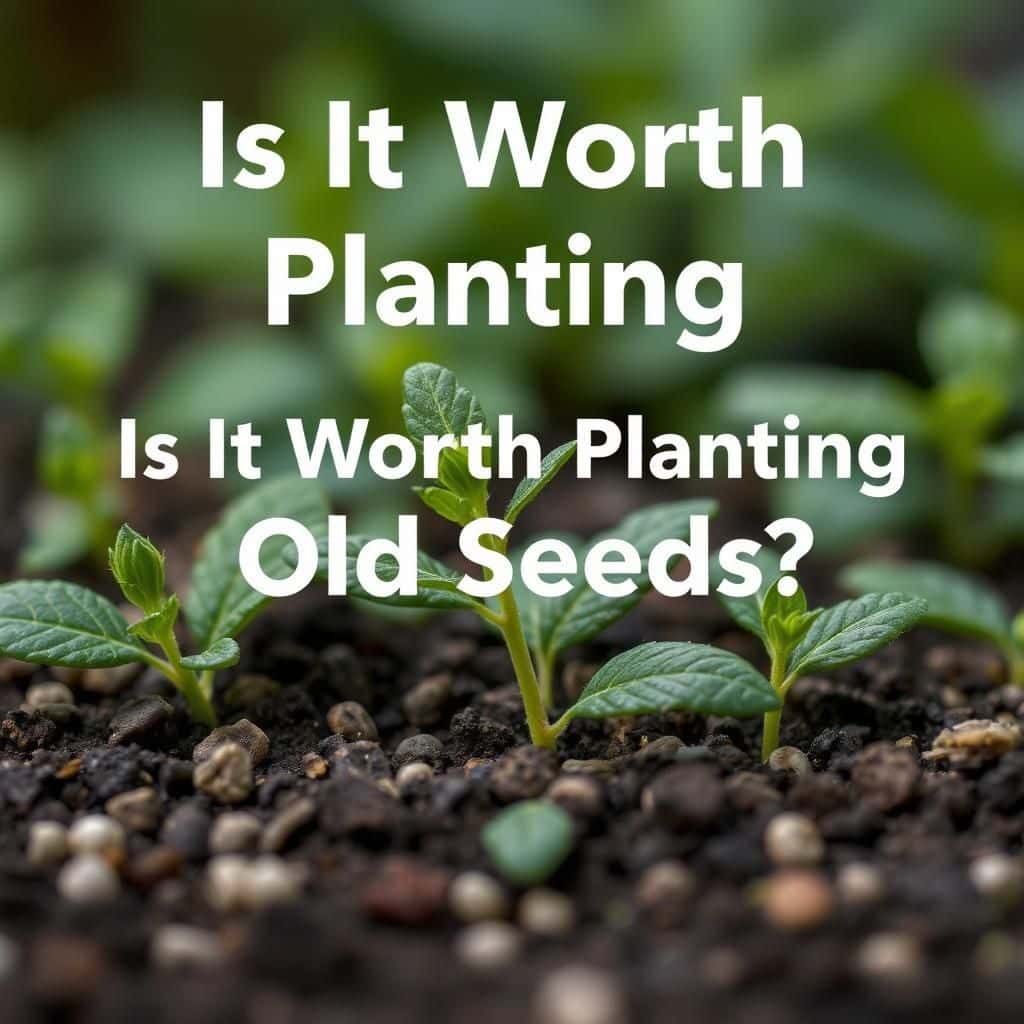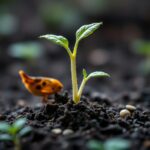Is It Worth Planting Old Seeds? A Comprehensive Guide to Seed Viability and Gardening Tips

Gardening enthusiasts often face the dilemma of whether to plant old seeds. With the potential for reduced germination rates and uncertain viability, the decision can significantly impact your gardening success. This comprehensive guide explores the factors influencing seed viability, offers practical tips for testing old seeds, and provides insights into optimizing your gardening practices. Whether you're a seasoned gardener or a novice looking to revive your planting routine, understanding the intricacies of seed longevity can help you make informed decisions. Join us as we delve into the world of old seeds and discover if they are worth the effort.
Is It Worth Planting Old Seeds?
Planting old seeds can be a cost-effective way to grow plants, but whether it is worth the effort depends on several factors such as the type of seed, its germination rate, and how well the seeds have been stored. Seeds that have been kept in optimal conditions—cool, dark, and dry—are more likely to retain their viability over time. However, if you are working with seeds that are several years old or if they have been stored improperly, you may face lower success rates in achieving a healthy crop. Testing seeds for germination by placing a few in a damp paper towel can help determine if it's worth the risk of planting them.
Factors Affecting Seed Viability
The viability of old seeds can be influenced by various factors such as the species of plant, the age of the seeds, and the conditions under which they were stored. For instance, vegetable seeds such as beans or peas typically have a longer shelf life compared to more delicate seeds like lettuce or tomatoes. Additionally, seeds that have been exposed to moisture, direct sunlight, or fluctuating temperatures may lose their viability more quickly. Therefore, understanding these factors is crucial for gardeners considering using old seeds.
How to Test Old Seeds
Testing old seeds for germination is a practical way to assess their viability before planting. A simple method involves taking 10 seeds and placing them on a damp paper towel. After a week or so, you can check how many seeds have germinated. This can give you a rough idea of the germination rate. If a significant portion of the seeds sprout, it might be worth planting them, but if less than half succeed, you may want to consider purchasing new seeds for better results.
Storage Tips for Seeds
Proper storage of seeds is essential to maintaining their viability over time. Ideally, seeds should be stored in a cool, dark, and dry place. Airtight containers such as glass jars or vacuum-sealed bags can help protect them from moisture and pests. Additionally, adding packets of silica gel can reduce humidity levels. Having a labeled system for organizing different types of seeds can also help you keep track of their age and ensure you're using the oldest ones first.
Benefits of Planting Old Seeds
There are several benefits to planting old seeds, primarily related to cost savings. Using seeds you already possess reduces the need to purchase new ones, which can be particularly advantageous for gardeners operating on a tight budget. Additionally, some gardeners enjoy the challenge of seeing if they can still bring life from older seeds, and there can be a sense of nostalgia associated with growing heritage or heirloom varieties passed down through generations. In some cases, old seeds may also carry unique genetic traits that are not readily available in newer hybrids.
When Not to Plant Old Seeds
Despite the potential advantages, there are times when planting old seeds might not be worth the effort. If the seeds are significantly beyond their recommended shelf life, or if they appear damaged or have signs of mold, it's best to avoid using them. Additionally, if you are relying on a specific crop for a limited growing season, the uncertainty of poor germination could lead to disappointing yields. In these cases, investing in new seeds may be the better option.
| Seed Type | Typical Shelf Life | Storage Conditions |
|---|---|---|
| Beans | 3-5 years | Cool, dark, dry |
| Tomatoes | 4-6 years | Cool, dark, dry |
| Lettuce | 2-3 years | Cool, dark, dry |
| Peas | 3-4 years | Cool, dark, dry |
| Cucumbers | 5-10 years | Cool, dark, dry |
How long can seeds sit before planting?

Seeds can generally sit for varying lengths of time before planting, depending on the type of seed, the storage conditions, and the intended planting time. In general, most seeds can remain viable for one to five years if stored properly. For some seeds, the longevity can be even longer, while others may require immediate planting for optimal germination. Here are some key factors to consider:
Storage Conditions
The way seeds are stored plays a crucial role in their longevity. Proper storage can significantly extend their viability. Here are some tips for storing seeds:
See also:
- Cool temperatures: Store seeds in a cool, dry place, ideally in temperatures below 50°F (10°C).
- Low humidity: Keep seeds away from moisture; use airtight containers to prevent humidity damage.
- Darkness: Store seeds in a dark environment to prevent light exposure, which can deteriorate seed quality.
Seed Types and Lifespan
Different types of seeds have varying lifespans before they need to be planted. Here are some general guidelines:
- Vegetable seeds: Most vegetable seeds can last from three to five years.
- Herb seeds: Herb seeds typically remain viable for two to three years.
- Flower seeds: Certain flower seeds can last from one to four years, depending on the species.
Seed Viability Tests
To ensure seeds are still viable before planting, conducting a seed viability test can be beneficial. Here’s how to perform one:
- Moist paper towel: Place seeds on a damp paper towel, fold it, and keep it in a warm area.
- Check germination: After a week or so, check the seeds for any signs of germination.
- Calculate viability: If most seeds germinate, they are likely still viable; if not, it's time to replace them.
Factors Influencing Germination Rates
Several factors can influence the germination rate of seeds that have been stored. Understanding these factors can help in seed selection:
- Age of seeds: Older seeds may have lower germination rates compared to fresher seeds.
- Seed genetics: Some seeds inherently have better longevity and germination rates than others.
- Storage conditions: As previously mentioned, improper storage can lead to reduced germination rates.
Best Practices for Seed Planting
To maximize the potential of seeds that have been sitting for a while, follow these best practices when planting:
- Plan ahead: Know the best planting times for each seed type to ensure optimal growth.
- Pre-soak seeds: Some seeds may benefit from soaking in water for a few hours before planting.
- Use quality soil: Ensure the soil is rich in nutrients to support seedling growth once germination occurs.
Can I use expired seeds for planting?

Using expired seeds for planting can be a tempting option for gardeners looking to save money or utilize seeds that have been lying around. However, understanding the viability and germination potential of these seeds is crucial before proceeding. Seeds can lose their viability over time, and their ability to sprout may be significantly reduced. Here’s a detailed look into the implications of using expired seeds.
Understanding Seed Viability
The concept of seed viability refers to the ability of seeds to germinate under optimal conditions. Seeds have a natural lifespan, and once they expire, their viability can decrease significantly. Several factors influence seed viability:
- Seed type: Different seeds have varying lifespans. For example, tomato seeds can last 4-6 years, while corn seeds may only last 1-3 years.
- Storage conditions: Seeds that have been stored in cool, dry, and dark places tend to remain viable longer than those kept in warm, humid environments.
- Seed treatment: Some seeds are treated with chemicals or preservatives that can extend shelf life, affecting their viability when expired.
Factors Affecting Germination Rates
Several factors can impact the germination rates of expired seeds. These include:
- Age of the seed: The older the seed, the less likely it is to germinate. As seeds age, their cellular integrity deteriorates.
- Environmental conditions: Even if seeds are still viable, they require the right conditions (temperature, moisture, light) to germinate successfully.
- Seed prep and treatment: Proper soaking or scarifying treatments can sometimes help older seeds germinate better.
Testing Expired Seeds for Viability
Before planting expired seeds, it is advisable to test their viability. Here is a simple method:
- Prepare a damp paper towel: Moisten a paper towel and wring out excess water.
- Place seeds on the towel: Space the seeds out to prevent crowding.
- Keep it warm and dark: Place the towel within a plastic bag and keep it in a warm location.
- Check for sprouts: After a week or two, check how many seeds have sprouted. A high germination rate (over 70%) indicates good viability.
Potential Risks of Using Expired Seeds
Planting expired seeds can pose various risks, such as:
See also:
- Low germination rates: Many seeds may fail to sprout, leading to poor yields.
- Weak plants: If a seed does manage to germinate, it may result in weak and unhealthy plants that are less resilient to pests and diseases.
- Time and resource wastage: Gardening requires time and effort, and using expired seeds could lead to wasted resources if plants do not thrive.
Best Practices for Seed Storage
To maximize seed potential, proper storage is key. Some best practices include:
- Cool, dry place: Find a temperature-controlled location to prevent moisture buildup.
- Airtight containers: Use glass jars or plastic bins to protect against humidity and pests.
- Labeling: Keep track of expiration dates and seed types for easier reference.
Why is it illegal to save seeds?

The legality of saving seeds varies significantly by country and is influenced by a number of factors including patent laws, agricultural regulations, and intellectual property rights. In many jurisdictions, it is illegal to save seeds primarily due to intellectual property laws and the interests of large agricultural corporations. Here's a more detailed exploration of this issue.
Intellectual Property Rights
The concept of intellectual property rights allows companies to patent their genetically modified organisms (GMOs) and crops. When a seed is patented, the company retains exclusive rights to its use and reproduction. This means that farmers who purchase patented seeds are typically not allowed to save seeds from their harvest for future planting.
- Patents grant the right to exclude others from making, using, or selling the invention.
- Saving patented seeds without permission constitutes a violation of those rights.
- The intention behind such patents is to incentivize innovation and recover research and development costs.
Commercial Farming Practices
Large-scale commercial farming often relies on hybrid or genetically modified seeds that are designed for high-yield production. These seeds usually do not perform well if replanted, which discourages farmers from saving them.
- Hybrids produce plants that do not maintain the quality or quantity of the original seed.
- Farmers tend to rely on purchasing new seeds each season to ensure optimal yield.
- Companies market these seeds with the promise of improving crop efficiency, making them appealing to farmers.
Regulatory Framework
Governments have set up regulatory frameworks governing the sale and usage of seeds, which include penalties for saving seeds in certain cases. These regulations aim to protect agricultural biodiversity and quality but often favor the interests of seed corporations.
- Licensing agreements outline the conditions for using patented seeds.
- Regulatory bodies enforce compliance, which can include inspections and fines.
- Farmers may find themselves facing legal action if they do not adhere to these regulations.
Seed Sovereignty Movements
Despite the legal hurdles, there are movements advocating for seed sovereignty—the right of farmers to save, use, and exchange seeds. These movements challenge the legal restrictions imposed by corporations.
- Seed sovereignty promotes genetic diversity and ecological balance.
- Activists often push for legislation to protect farmers' rights to save seeds.
- Collective efforts lead to community seed banks that preserve traditional varieties.
Impact on Biodiversity
The restriction on saving seeds can significantly impact biodiversity. When large corporations control seed production, it often leads to reduced genetic diversity in crops, which can make food systems more vulnerable to pests and diseases.
- Uniformity in crops increases risks associated with monoculture farming.
- Genetic diversity is essential for resilience against climate change.
- The loss of traditional varieties often means loss of local agricultural knowledge and practices.
Questions from Our Readers
Is it worth planting old seeds?
Although it can be tempting to plant old seeds, success is not guaranteed. Over time, seeds lose their viability and may not germinate, leading to disappointing yields. However, if properly stored, some seeds can remain viable for several years. It’s recommended to perform a germination test before planting to assess their potential.
How can I tell if old seeds are still viable?
To determine the viability of old seeds, you can conduct a simple germination test. Place a few seeds between damp paper towels and keep them in a warm location. After a week or so, check for germination. If a significant percentage sprout, it indicates that the seeds are still viable and worth planting.
See also:
What factors affect the viability of old seeds?
The viability of seeds can be influenced by several factors, including age, storage conditions, and seed type. Seeds exposed to humidity, heat, and light can deteriorate faster. Properly stored seeds in cool, dark, and dry conditions tend to retain their germination ability longer.
Should I plant old seeds or buy new ones?
Deciding whether to plant old seeds or buy new ones depends on the viability of the old seeds and your gardening goals. If you perform a germination test and find the old seeds are still good, it may be worthwhile to use them. However, if you seek reliable results and better yields, investing in new seeds might be a smarter choice.

If you want to read more articles like Is It Worth Planting Old Seeds? A Comprehensive Guide to Seed Viability and Gardening Tips, we recommend you check out our Seeds category.
Leave a Reply
Related Articles